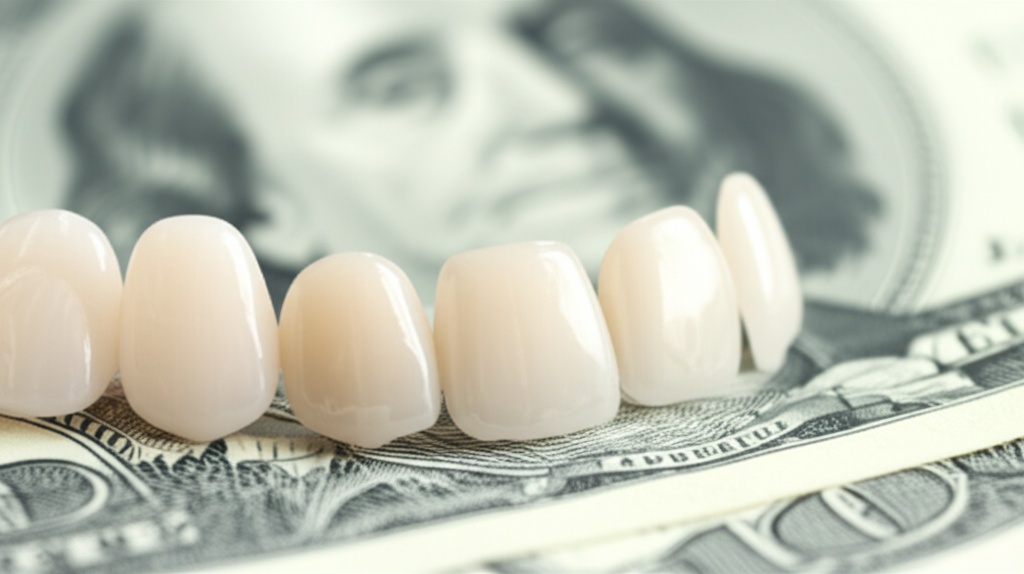
How Much Do Dentists Charge for Veneers? Your Ultimate Cost Guide
Want to know how much dentists charge for veneers? This article gives you a simple, clear guide to the real prices of dental veneers. You’ll find easy facts, honest advice, and ways to pay less so you can get the smile you want. Whether you want a full smile makeover or just cover up a chipped tooth, knowing the real cost of veneers is the first step.
In this guide, you’ll find out:
- The average price of veneers per tooth and for a full set
- What makes prices go up or down
- Smart ways to pay for veneers
- Truth about hidden fees
- How to decide if veneers are really worth it
Let’s break down these numbers so you can choose what’s right for your teeth and your wallet.
Table of Contents
Introduction: What Are Dental Veneers and Who Needs Them?
First, let’s explain. Dental veneers are thin covers made just for you that stick to the front of your teeth. Dentists use them to fix stained teeth, chipped teeth, gaps, or even some crooked teeth. If you don’t like your smile, veneers can help you feel better.
A lot of people ask, “Are veneers right for me?” It depends on what you want and how much you want to spend. Veneers are not the only way to change your smile, but they can work fast and make a big difference.
Most dentists say veneers are best for adults who want to change how their teeth look. Your teeth and gums should be healthy first. Some people just get one veneer to fix a tooth, others get several for a full smile change.
What Is the Average Cost of Veneers Per Tooth and for a Full Set?
So, what do dentists usually charge for veneers? The price can change a lot. Here’s why:
- Type of veneer (porcelain, composite, no-prep)
- Dentist’s skills
- Where the dentist is located
- How many teeth you want treated
- Extra work needed, like gum fixes or repairs
Here are some real numbers from dental experts and the American Dental Association:
| Veneer Type | Cost Per Tooth | Cost for Upper 8-10 Teeth |
|---|---|---|
| Porcelain Veneers | $900 – $2,500+ | $10,000 – $30,000+ |
| Emax Porcelain | $1,200 – $3,000+ | $12,000 – $35,000+ |
| Lumineers (No-Prep) | $800 – $2,000 | $8,000 – $25,000+ |
| Composite Veneers | $250 – $1,500 | $3,000 – $15,000+ |
Source: National dental price reports, ADA.
You’ll see the price goes up if you need more teeth done. Getting just one veneer for a chipped tooth might be $900 to $3,000, but a full smile makeover can cost as much as a new car!
How Much Do Porcelain Veneers Cost?
When people talk about veneers, they usually mean porcelain veneers. These are known as the best type in cosmetic dentistry. Dentists like porcelain because it looks like real teeth and lasts a long time—sometimes 10 to 15 years or more if you look after them.
Usually, you can expect to pay:
- $900 to $2,500 per tooth for basic porcelain
- $1,200 to $3,000 per tooth for high-end Emax veneers
Yes, the price is a range, not one number. The exact price depends on a few things. First, special labs can charge more for really good results.
Second, some dentists charge more because they use fancy technology or high-end labs—like digital dental labs.
Third, big cities like New York or LA often cost more because the rent is expensive.
Tip: Ask your dentist if they use pressed ceramics or Emax—they can look and last better.
Are Composite Veneers Really Cheaper?
Maybe porcelain is just too much. That’s where composite veneers, or “dental bonding,” comes in. Composites are made by the dentist in the office, using a tooth-colored material. Composite veneers are not as strong or shiny as porcelain, but the price is much lower.
Most of the time you’ll pay:
- $250 to $1,500 per tooth
Composite is a good choice if you need to save money. It’s quick and works for chipped or slightly uneven teeth. The downside? Composites don’t last as long—about 5 to 7 years—and can stain more easily.
For a lot of families, composite is a way to afford a better smile. If your budget is tight, ask your dentist about this option.
What About Lumineers and No-Prep Veneers?
You might hear about Lumineers or no-prep veneers. These are very thin porcelain covers and need little or no drilling. Your real teeth stay almost the same. If you worry about drilling or want an option that is easier to undo, these are popular.
Usual price:
- $800 to $2,000 per tooth
Lumineers don’t work for everyone, especially if your teeth are dark or uneven. Sometimes they can look a bit thick if your teeth already stick out. But for small teeth or small problems, they’re a gentle way to fix your smile.
Many clinics work with top labs for these thin veneers. Ask which brand or lab your dentist uses if you want more details.
Why Does Veneer Pricing Vary So Much?
Why did your friend pay less (or more) for veneers? Here’s why:
1. Veneer Type
Porcelain, Emax, composite, and Lumineers all cost different amounts. Porcelain usually costs more but lasts longer and looks best. Emax is even stronger. Composite is the cheapest, but not as tough.
2. Number of Veneers
It’s simple: the more veneers, the higher total price. But some dentists give a better deal for a group.
3. Dentist’s Skills
A dentist with lots of training and experience may charge more. You pay for their know-how, and often results are better.
4. Where the Clinic Is
Dentists in big cities charge more than those in small towns. Some people even travel overseas to save money—that’s called dental tourism.
5. Extra Dental Work
If you need fillings, gum shaping, or teeth whitening, your bill goes up. Sometimes, dentists do a mockup of your new smile in 3D—that can cost $100–$500 and helps you see what you’ll get.
6. Lab Fees
Good labs give the most natural and long-lasting results, but can cost more.
Can Dental Insurance Help Pay for Veneers?
Here’s the straight answer:
Most dental insurance does NOT pay for veneers. They’re labeled “cosmetic,” which means you want them to look better, not for health.
Small exceptions:
- If you lost a tooth in an accident or need repairs after a trauma, insurance might help a little.
- Sometimes, if the veneer is used instead of a crown for a broken tooth, your insurance may help partly.
Every insurance is different, so check yours!
For most people, you’ll pay from your own pocket. That’s why you should get a full price quote from your dentist first.
What Payment Plans and Financing Options Exist?
Don’t worry if the price is too high at first—most dentists know veneers are expensive. You have ways to pay over time:
- Dental payment plans: Pay a bit each month instead of all at once.
- Third-party financing (like CareCredit): These let you pay over several months, sometimes without interest for a while.
- HSAs or FSAs: If your job offers these, you can use before-tax money to help pay.
- Credit cards or loans: These work too, but be careful about interest.
See if your dentist works with more than one finance company—sometimes, comparing plans gets you a better deal.
Should I Consider Dental Schools or Dental Tourism?
If veneers cost too much, you have two more options:
1. Dental Schools
Dental schools often have special clinics where students (supervised by dentists) do veneers for less money. But, visits may take longer because it’s a learning environment.
2. Dental Tourism
Some people travel to countries like Mexico or Turkey for cheaper veneers. Prices can be 50–70% less, but you must pay for travel and hotel, and there may be risks if you need help later. Do lots of research and look for clinics with good reviews.
Are There Cheaper Alternatives to Veneers?
Before you spend a lot, see how veneers compare to other ways to fix your smile:
| Option | Cost Per Tooth | Lasts | Good For |
|---|---|---|---|
| Dental Bonding | $100–$1,000 | 3–7 years | Small chips, stains, gaps |
| Dental Crowns | $800–$3,000 | 10–15 years | Weak or broken teeth |
| Braces/Invisalign | $2,000–$7,000+ | Permanent | Crooked or crowded teeth |
Bonding is fast and much cheaper, but doesn’t last or look as good as porcelain veneers. Crowns help if your tooth is broken badly. Braces work if your teeth are crooked, but it takes time.
What Hidden Costs Should I Watch Out For?
I always tell people: Ask for the full price before you start. Extra costs can surprise you:
- Consultation fee: Some dentists charge for the first visit, others don’t.
- Temporary veneers: If you need to wear practice veneers, this costs extra.
- Other dental work: Fillings, root canals, or gum fixing adds to the price.
- Fixing or replacing: Veneers can break or come off. Fixing just one can cost as much as when it was new.
- Extra care: Special cleanings, night guards, and polishes help your veneers last.
Make sure your dentist or patient dental support tells you all this before you start.
Is the Investment in Veneers Worth It?
Yes, veneers are expensive. But for many people, they’re worth it. Why? A new smile can do more than change your teeth—it boosts your confidence, can make you look younger, and makes you want to show your smile.
Ask yourself:
- Do I want a fast, big change to my smile?
- Will I look after my veneers?
- Do I trust my dentist?
If you said yes, veneers could be a great choice for you.
Frequently Asked Questions About Veneer Cost
Q: What’s the cheapest way to get veneers?
A: Composite veneers or going to a dental school are least expensive. You might save money going overseas, but check pros and cons.
Q: How many veneers do most people get?
A: Most people get 4, 6, 8, or 10 for their top teeth. Some get all 16–20 teeth done.
Q: How long do veneers last?
A: Porcelain and Emax can last 10–15 years or more with good care. Composite lasts 5–7 years. A night guard helps protect them.
Q: Can my veneers get stains?
A: Porcelain hardly stains, better than real teeth. Composite can stain from things like coffee or smoking.
Q: Do veneers ruin my teeth?
A: Dentists remove a thin layer of enamel to fit veneers, but it’s small and needed.
Key Points to Remember
- Veneer prices range from $250 to over $3,000 per tooth, depending on type, dentist, and location.
- Porcelain and Emax look best and last longest, but composite is cheapest.
- Most insurance doesn’t pay for veneers unless there’s an emergency or accident.
- Payment plans, HSAs, and dental schools help you save money.
- Always ask the dentist to explain costs up front. No surprise bills!
- With good care, veneers can make your smile better for more than 10 years.
- If veneers are too costly, look into bonding, crowns, or braces as other options.
- Working with a top-rated china dental lab can help make sure you get high quality results.
You should know all the facts before making this choice for your smile. Now that you understand the prices, the next step is to talk to a good cosmetic dentist and get your own quote. Why wait? Your confident new smile could be just ahead!








